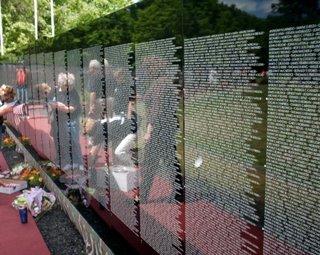Vietnam Vet Recalls Threat of Nuclear War

SARATOGA SPRINGS - Lee Nicholls stood on a patch of earth decorated with military stars and pointed his way around Congress Park to some of the projects he created for this city.
'That fountain over there,' he said, gesturing at a trickling waterfall. 'This planter at the top of the hill,' he said, nodding his head in the direction. 'The sign over there at the spring,' he offered, before turning his attentions to the plaques commemorating servicemen and women inside the octagon-shaped War Memorial.The one in particular that caught his eye honored those who served from 1917-1918. Nicholls pointed out a name that read Everett Lee.
'That was my grandfather,' he said.
A few miles away, a different era was being remembered. One that was in Nicholl's lifetime.
'That whole period had a certain amount of idealism to it. America was young and thought that it could do anything in those days,' he said. 'That's why we have a Peace Corps. That's why we have special (operations) forces,' said Nicholls, who spent time with both.
After surviving the notoriously tough and extensive training of Basic Underwater Demolition School (BUDS), he joined the Underwater Demolition Team. The UDTs were the Navy Special Warfare unit and a pre-cursor of the Navy SEALs.
'The SEALs were formed out of the Underwater Demolition Team in January 1962. They were the brainchild of JFK,' Nicholls said.
'During the Cuban Missile crisis, I was in the Cuba area on a submarine. During that whole period we were conducting training missions, and I'll tell you from one day to the next, I didn't know whether we would wake up and find ourselves in a nuclear war,' he recalled. 'We didn't find this out until much later, but the Russians already had tactical nuclear artillery weapons ashore, which means all us froggies would have been crispy critters.'
'We were sending people to Vietnam since 1961,' said Nicholls, who went into the Navy in 1959 and was honorably discharged in 1963 before serving another four years in the active reserves.
'I wasn't in Vietnam but I had an instructor, and several of my classmates who went. Out of the 840-something we sent to Vietnam from my teams, 49 are dead and I couldn't tell you how many were wounded,' he said. 'Sometimes when I go to the reunions and I see these guys missing pieces of an arm or an eye, I feel like a truant from school.' he said, flanked by eight columns supporting the open-air War Memorial.
'Here we sit at a monument of wars to end all wars. The nobility is reflected in this monument, the way it is open on top and you could see the stars at night,' he said.
'After the war to end all wars, the war where my grandfather died, they said: 'Never again.' And after Vietnam, I thought it would never happen again, but in the midst of all this irony you develop a certain amount of cynicism.
I have a couple of buddies I know were Vietnam. I asked one of them if he was going to go see The Wall. He said no, he couldn't go through it all again. For a lot of people, it's like that. It's just too painful.'
by Thomas Dimopoulos published in The Saratogian, June 12, 2006

